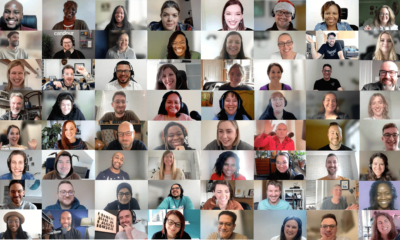SEO
How To Optimize YouTube Videos To Help Ukraine
Back on Feb. 11, 2022, the marketing team at SE Ranking, then located in Kyiv, Ukraine, invited me to give an online presentation about my Search Engine Journal article entitled, “Video SEO: 10 Steps to Optimizing Videos for Search and Discovery.”
I quickly accepted.
I didn’t hear back from them for several days, and I learned later from Svetlana Shchehel, an editor at SE Ranking and fellow SEJ contributor:
“Some of us have spent days on the road striving to bring our families to a safer place. Some are still in Kyiv and other cities of Ukraine, trying to do their daily routine to the sounds of air raid sirens.
All of us feel scared and devastated, but also hopeful and strong.”
That’s when I decided to go beyond presenting a PowerPoint version of my Search Engine Journal article.
And that’s why I opened my presentation at their webinar on April 14 with a snapshot of “The real price of war.”
I said, “Ukrainians are a big part of the SE Ranking team. Tatiana Perebeinis, the chief accountant of SE Ranking, and her two children, Mykyta, 18, and Alisa, 9, along with a church volunteer helping them, Anatoly Berezhnyi, 26, were killed on Sunday, March 6, crossing the concrete remnants of a damaged bridge in their town of Irpin, to evacuate to Kyiv.”
Now, as I said then, I can’t help Ukraine produce more YouTube videos that people in Europe will watch and share.
But I can teach you how to optimize videos that tell the truth about the war, so they are discovered when people conduct relevant searches on YouTube, the world’s second-largest search engine.
Here’s a quick reference, and we’ll dig in below.

How YouTube’s Algorithm Works
YouTube’s algorithm tries to match each viewer to the videos they are most likely to watch and enjoy.
With more than 500 hours of video content uploaded every minute, this is quite a challenge.
YouTube’s search and discovery systems tackle this Herculean task by paying attention to viewers instead of videos.
YouTube’s algorithm “follows the audience” by paying attention to things like:
- What they watch.
- What they don’t watch.
- How much time they spend watching.
- Their sharing, likes, and dislikes.
- “Not interested” feedback and satisfaction surveys.
Next, I explained that YouTube has multiple algorithms, including ones for:
- YouTube Search: Videos are ranked based on how well the title, description, and video content match the viewer’s search and which videos drive the most engagement for a search.
- Up Next: Videos are ranked to offer viewers videos they’re most likely to watch next. These videos are often related to the video an audience is watching, but they can also be personalized based on watch history.
- Your homepage: Videos are selected based on how well they have interested and satisfied similar viewers, how often viewers watch a channel or topic, and how many times YouTube has already shown each video.
- YouTube Shorts: YouTube wants both short and long videos to succeed. So, broadly speaking, relative watch time is more important for short videos, and absolute watch time is more important for longer videos.
But you don’t have to be an expert in YouTube’s algorithms to be successful. Instead, you focus on knowing your audience.
YouTube’s search and discovery system doesn’t “promote” videos to your audience. It ‘finds’ videos for each viewer and their varying interests.
The goal is to get people to watch more videos they enjoy so they will come back to YouTube regularly.
For example, Volodymyr Zelensky, President of Ukraine, made an emotional appeal to members of the U.S. Congress for additional help in defending Ukraine from Russia’s invasion.
His 18-minute address included a powerful video set to haunting violin music, juxtaposing Ukraine’s pre-invasion joy and beauty with graphic images of the war’s death and destruction that brought some lawmakers to tears.
And Tubular Labs data shows 174 accounts uploaded 217 videos about this event to YouTube, resulting in 5.3 million views and 130,000 engagements (e.g., likes, comments, shares).
Most were uploaded in the News & Politics category, but the video with the most views and engagements was “Trump Dials Back Putin Praise, Russia Sanctions Prominent Americans & Zelensky Addresses Congress,” which was uploaded in the Comedy category by Jimmy Kimmel Live!
 Screenshot from YouTube, March 2022
Screenshot from YouTube, March 2022
Jimmy Kimmel’s 14:06-long monologue got 1.6 million views and 28,500 engagements.
WION, an Indian multinational English language news channel headquartered in New Delhi, uploaded a news story that was 48:13-long, which got 561,000 views and less than 7,800 engagements.
Meanwhile, CNN’s 6:06-long news story got 371,000 views and 13,400 engagements. I’d call these results counter-intuitive.
After providing this background, I presented an update to the 10 steps for optimizing videos.
Step 1: Conduct Keyword Research For YouTube
The first step is conducting keyword research.
Instead of trying to cover the 10 best YouTube keyword tool alternatives, I focused on just four:
- Search predictions: Start typing a term in YouTube’s search box. The autocomplete feature will provide you with a series of search predictions related to what you’ve already typed in and what other people are searching for.
- Keyword Tool for YouTube: The Keyword Tool for YouTube pulls more than 750 long-tail search term suggestions from YouTube’s search predictions by appending and prepending the keyword you specify with letters and numbers.
- Google Trends: Google Trends shows you “web search” interest by default. But, click on the Web Search button, and a drop-down menu will show you other options, including YouTube Search trends back to 2008.
- vidIQ: When you search on YouTube, vidIQ displays how hot (or not) the keyword or phrase is based on its search volume and competition. It’s also worth noting that Ukrainians make up a large part of vidIQ’s team.
Step 2: Optimize Videos Specifically For YouTube Search
The second step is optimizing your videos for YouTube Search, which prioritizes:
- Relevance: YouTube looks at many factors, such as how well the title, description, hashtags, and video content match a viewer’s search query.
- Engagement: YouTube looks at the watch time of a particular video for a particular query to determine if the video is considered relevant to the query by other users.
- Quality: YouTube’s systems are designed to identify signals that can help determine which channels demonstrate expertise, authoritativeness, and trustworthiness on a given topic.”
And I shared the following tips for optimizing your titles:
- Use compelling titles for your videos that accurately represent the content.
- Keep your titles concise – under 50 characters.
- Put the most important information up front and your hashtags, branding, or episode numbers towards the end.
- Avoid misleading, clickbait, or sensational titles, making your video less likely to be recommended to viewers.
Step 3: Optimize Video Descriptions
The third step is optimizing both parts of your descriptions – what viewers see before they click Show more and what they see after.
In June 2020, YouTube introduced Video Chapters, which add context to each portion of the video.
And in January 2021, YouTube launched a new search results page that appears when users look for videos by hashtag.
So, here’s how to optimize your descriptions:
- Use the first few lines of text to explain what the video is about using search-friendly keywords and natural language.
- Use the rest of the text (what shows up once they click Show more) to provide around 200 to 350 words of extra information.
- Add Video Chapters, which use timestamps to allow viewers to watch or rewatch a specific section of a video.
- Use related hashtags (#) to help viewers find your video when searching for a specific topic on YouTube.
Step 4: Optimize Video Thumbnails
The fourth step is optimizing your thumbnails.
I said, “Video thumbnails let viewers see a quick snapshot of your video as they’re browsing YouTube. After uploading your video, you can add a custom thumbnail if your account is verified or choose one of the three thumbnail options that YouTube automatically generates.”
I added, “Your custom thumbnail image should be as large as possible.”
Custom thumbnails should:
- Have a resolution of 1280×720 (with a minimum width of 640 pixels).
- Be uploaded in image formats such as JPG, GIF, or PNG.
- Remain under the 2MB limit.
- Try to use a 16:9 aspect ratio as it’s the most used in YouTube players and previews.
But, I also cautioned:
- Make sure your thumbnail follows YouTube’s thumbnail policy.
- Create thumbnails that accurately represent your content.
Step 5: Optimize For YouTube’s Recommendation System
The fifth step is optimizing your videos for YouTube’s recommendation system, which drives a significant amount of the overall viewership on YouTube, even more than channel subscriptions or search.
And YouTube’s recommendation system works in two main places: The “Up Next” panel and a viewer’s homepage.
The “Up Next” panel suggests additional content based on whatever a viewer is currently watching, alongside other videos YouTube thinks the viewer may be interested in.
So, here’s how to optimize videos, so they’re Up Next:
- Make strong calls to action to encourage viewers to watch another video in your series.
- Long endings may delay viewers from watching more, so be mindful of how your videos end.
- Use links, cards, and end screens to suggest the next video that your viewer may be interested in watching.
- Develop playlists that are organically connected by a specific theme or tent-pole event to create a long viewing experience.
Step 6: Encourage Viewers With Links, Cards, And End Screens
The sixth step is optimizing your links, cards, and end screens.
Links in your description can encourage viewers to take an action, which is an engagement signal.
Cards work well when in conjunction with scripted calls to action or when they’re relevant to your video content.
End screens can be added to the last 5–20 seconds of a video to promote other videos, encourage viewers to subscribe, and more.
So, here are some video SEO best practices:
- Use cards in older videos to highlight your most recent uploads or promote fundraising campaigns.
- Use cards to cross-promote other creators and credit collaborators in your video.
- Leave enough space and time at the end of your video (the last 20 seconds) for an end screen.
- Encourage viewers to click using calls to action for different end screen elements and show them at different times.
Step 7: Remember The “4 Rs”
The seventh step is fighting misinformation.
For content where accuracy and authoritativeness are key, including news, politics, medical, and scientific information, YouTube uses machine learning systems that prioritize information from authoritative sources.
And certain types of misleading or deceptive content are not allowed on YouTube, including misinformation that can cause real-world harm.
For example, YouTube blocked Russia’s state-backed channels RT and Sputnik across Europe on March 1, 2022.
And YouTube started blocking access worldwide to channels associated with Russian state-funded media on March 11.
YouTube cited a policy barring content denying, minimizing, or trivializing well-documented violent events. YouTube added that Russia’s invasion of Ukraine now fell under this policy, and violating material would be removed.
Here are the “4 Rs” YouTube’s machine learning systems use:
- Remove content that violates their policies.
- Reduce recommendations of borderline content.
- Raise authoritative sources for news and information.
- Reward trusted creators.
Step 8: Optimize For User Homepage
The eighth step is optimizing videos for a user’s homepage.
The homepage is what a user sees when they first open YouTube.
It displays a mixture of personalized recommendations, subscriptions, and the latest news and information.
Unlike other platforms, YouTube doesn’t connect viewers to content through their social network.
Instead, YouTube’s recommendation system is constantly evolving, learning from over 80 billion signals every day to help people connect to videos they love.
So, I shared these observations:
- Recommendations connect viewers to high-quality information and minimize the chances of seeing problematic content.
- Any video that YouTube classifies as “borderline content” is demoted in recommendations.
Step 9: Set Up A Regular Publishing Cycle
The ninth step is publishing content frequently and regularly.
A good frequency to aim for is a minimum of two videos per week, but the right amount of content depends on your audience, your goals, and your content.
And release videos on a set day of the week, if possible. Releasing videos on a recurring schedule helps build a structure to your channel that an audience can rely on.
Then, I shared the following ways to optimize your programming:
- Upload new videos consistently to give your audience an expectation of when they can see more new content.
- Keep viewers engaged for longer and encourage them to come back for more.
- Keep doing what works. Don’t be afraid to experiment, but do so mindfully.
- See how often your channel appears on Home, globally, by going to your YouTube Analytics Traffic Sources report.
Step 10: Create Shorts
The tenth step is getting started with YouTube Shorts.
In my article, “YouTube Shorts: An Introductory Guide,” I said,
“You might mistakenly think that Shorts is merely a bunch of creation tools that make it easy to create short-form videos up to 60 seconds long with a multi-segment camera.”
But, I added, “Viewers may find your Shorts by tapping Shorts at the bottom of the YouTube app.”
They may also find Shorts:
- On the YouTube homepage.
- In their notifications.
- By checking their Subscriptions.
- Featured on your channel page.
YouTube is also testing new ways to deliver Shorts. For example, once viewers tap into a Short, they can scroll to watch more short videos.
So, why should you jump on the bandwagon?
YouTube CEO Susan Wojcicki revealed in January 2022,
“We’re seeing momentum across the platform, including on Shorts. We’ve now hit 5 trillion all time views on Shorts!”
After presenting the 10 steps to optimizing videos for search and discovery, I encouraged attendees to apply what they had learned.
They weren’t in a position to stop missile strikes or Russian troops, but they could tackle other strategic threats to Ukraine, including misinformation, fuel, and food.
I suggested that Oleksandr Tkachenko, the Minister of Culture and Information Policy of Ukraine, could use their help.
In February 2022, his Ministry launched an operational press center with Ukrinform National News Agency and the Center for Strategic Communication and Information Security to provide daily updates on Russia’s “disinformation war.”
On March 18, 2022, Tkachenko said,
“Russian propaganda has driven itself into a dead end, so it has completely switched to the Russians – to brainwash them.
Roskomnadzor is trying to block all resources that might tell the truth to the Russians. But they’ve lost control. And soon, the refrigerator at home will win over the TV at home for the Russians.”
But, there is another way to tell the truth to the Russians.
YouTube has escaped any major censorship since the Russian invasion of Ukraine, despite the company suspending all monetization in Russia.
So, optimizing Ukraine’s videos in Russian could help Tkachenko tell the truth about the war to 106 million YouTube users in the Russian Federation.
I also suggested helping Bill McKibben, founder of Third Act, which is organizing people over the age of 60 to defend our climate and democracy.
He’s pushing a plan called Heat Pumps for Peace and Freedom.
In an op-ed entitled, “Heat pumps could help ease the climate crisis — and the war in Ukraine,” which was published by The Boston Globe on April 4, McKibben explained,
“Putin built his army on oil and gas earnings, and he’s made Europe cower by threatening to turn off the energy spigot. Both can be addressed in part by the massive application of technology.
The simple heat pump, for instance, which is basically a highly efficient air conditioner that also works in reverse, uses electricity to take the ambient heat from the outside air to warm a home.”
Does this plan seem farfetched?
Well, five U.S. Senators – including both Elizabeth Warren and Ed Markey of Massachusetts – have written to the White House asking President Biden to invoke the Defense Production Act, which would get America’s air conditioning factories to start churning out heat pumps for immediate export.
And you can help McKibben by optimizing YouTube videos in more than 100 countries around the world, across 80 languages, to build support for this strategic plan to deliver millions of heat pumps to Europe before October, making Putin’s energy weapon much stronger less potent.
Finally, I suggested helping David Wells, Senator for Newfoundland and Labrador in the Canadian Parliament’s Upper Chamber, Vice President of the Canada-Europe Parliamentary Association, and Canada’s delegate to the Parliamentary Assembly of the Council of Europe.
Senator Wells spoke on March 31 at a “Geoeconomic RoundTable: War in Ukraine – Political and Economic Forum,” which discussed how the invasion of Ukraine is affecting global food security. He said,
“David Beasley, executive director of the U.N. World Food Program, told the U.N. Security Council this week that the war in Ukraine has created ‘a catastrophe on top of a catastrophe’ and will have a global impact ‘beyond anything we’ve seen since World War II’ because many of the Ukrainian farmers who produce a significant amount of the world’s wheat are now fighting Russians.
He also stated that the war in Ukraine is turning ‘the breadbasket of the world to breadlines.”
 Screenshot from Geoeconomic RoundTable: War in Ukraine – Political and Economic Forum, March 2022
Screenshot from Geoeconomic RoundTable: War in Ukraine – Political and Economic Forum, March 2022
Senator Wells added,
“It is imperative that we establish a long-term strategic plan to address this situation as well as plan for the future as this crisis has changed the playing field possibly for generations.
Canada, as the fifth largest supplier of wheat in the world, is a key player and can participate in a long-term strategy.”
And, you can help Senator Wells by optimizing a series of videos that explain Ukraine’s absence from the world’s grain market will cause “a significant dent in world supply” and a problem in price.
“This will be a huge issue for the world’s poorer countries – particularly in Africa and Asia,” he said.
There are many other ways SEOs and digital marketers can #standwithukraine.
Miranda Miller outlined them in her post, “SEO Community Support For Ukraine & How You Can Help.”
In short, do something.
You can’t control who lives, dies, or tells your story, but you can influence all three outcomes.
More resources:
Featured Image: Darya Lavinskaya/Shutterstock
!function(f,b,e,v,n,t,s)
{if(f.fbq)return;n=f.fbq=function(){n.callMethod?
n.callMethod.apply(n,arguments):n.queue.push(arguments)};
if(!f._fbq)f._fbq=n;n.push=n;n.loaded=!0;n.version=’2.0′;
n.queue=[];t=b.createElement(e);t.async=!0;
t.src=v;s=b.getElementsByTagName(e)[0];
s.parentNode.insertBefore(t,s)}(window,document,’script’,
‘https://connect.facebook.net/en_US/fbevents.js’);
if( typeof sopp !== “undefined” && sopp === ‘yes’ ){
fbq(‘dataProcessingOptions’, [‘LDU’], 1, 1000);
}else{
fbq(‘dataProcessingOptions’, []);
}
fbq(‘init’, ‘1321385257908563’);
fbq(‘track’, ‘PageView’);
fbq(‘trackSingle’, ‘1321385257908563’, ‘ViewContent’, {
content_name: ‘youtube-videos-help-ukraine’,
content_category: ‘seo youtube’
});



















You must be logged in to post a comment Login